Introduction
Front
{{section_header}}{{section.name}}{{/section_header}}
A stainless facsimile covers the front of the {{product.name}}. It's laminated and easier to clean than true stainless, but if that laminate is ever scratched the surface beneath can rust. A hard, black plastic icemaker doesn't help the fridge look very modern.
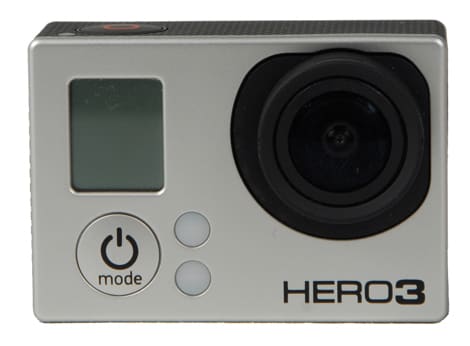
Controls are on the fridge exterior, right above the ice/water dispenser. Unlike most mid-range fridges, the temperature controls actually display a true temperature instead of a number between one and four, or a series of stars. You can even make the temperature go up or down without scrolling through every potential option.

Short, rounded handles open both fridge and freezer.

There's a single lever for water or ice. Buttons above the chute allow the user to choose among crushed ice, cubed ice or water. There's also a light and a reminder to change the water filter.

Interior
{{section_header}}{{section.name}}{{/section_header}}
Inside, a traditional interior awaits. Shelves hang off of rails in the back of the fridge rather than sliding into grooves on the side of the unit.
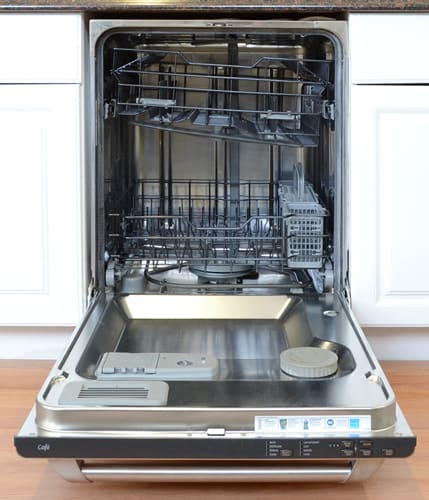
The interior of the CDWT980VSS.
There's a water filter in the top right rear of the fridge compartment.
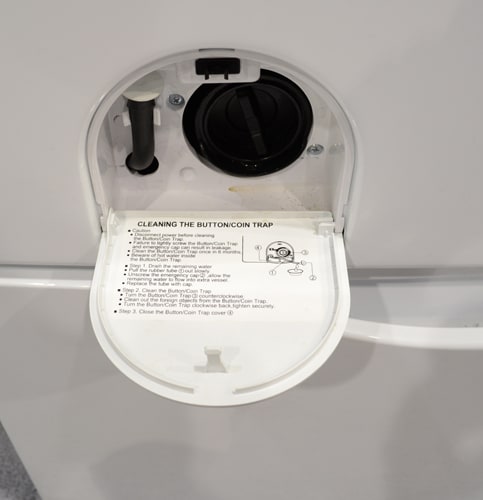
Ice is made in the top of the main freezer compartment, then dispensed through a chute in the freezer door.
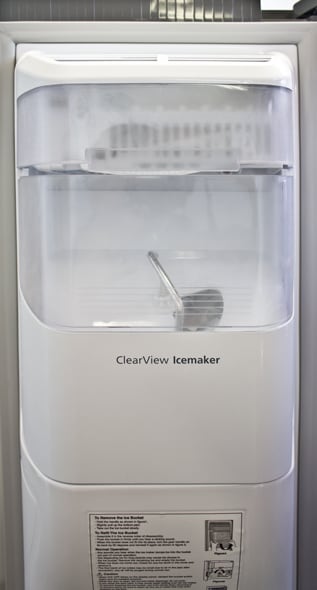
Back
{{section_header}}{{section.name}}{{/section_header}}
Most fridges have a black cord and an unpainted metal back. The {{product.name}}'s rear is black, and its cord is brown. There's also a water line hookup back there.
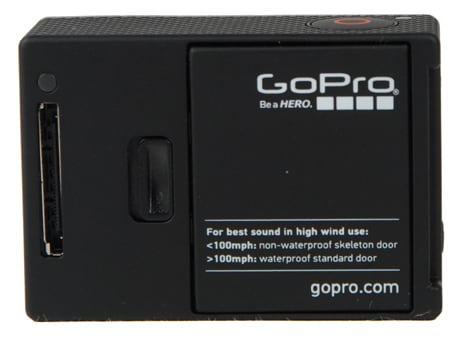
Sides
{{section_header}}{{section.name}}{{/section_header}}
The sides of the fridge are textured and black.
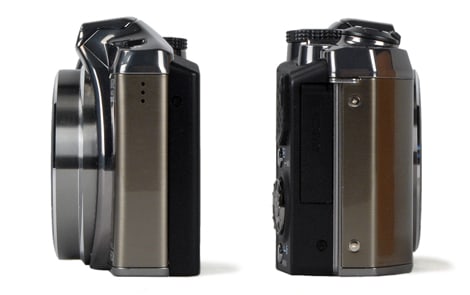
Olympus SZ-31MR iHS side views
Running Cost
{{section_header}}{{section.name}}{{/section_header}}
After testing the average 24 hour power consumption of the {{product.name}} over a five-day period, we estimate that a year's worth of running the fridge would cost just $32.57, if power sells for 9.1 cents per kWh where you are. That's low for a fridge.
Power Use Per Cu Ft
{{section_header}}{{section.name}}{{/section_header}}
So we can compare this fridge's power use with models of different sizes, we divide energy consumption over total usable storage space. The {{product.name}} is extremely efficient in this regard.
Fridge Temperature
{{section_header}}{{section.name}}{{/section_header}}
Though temperatures within the fridge remained consistent over time, this GE suffered the same malady as many tall side-by-sides: The temperature is cooler towards the vent. Since air can't circulate well through a full fridge, lower shelves were as high as 41 degrees while the top shelves were as low as 36 degrees.
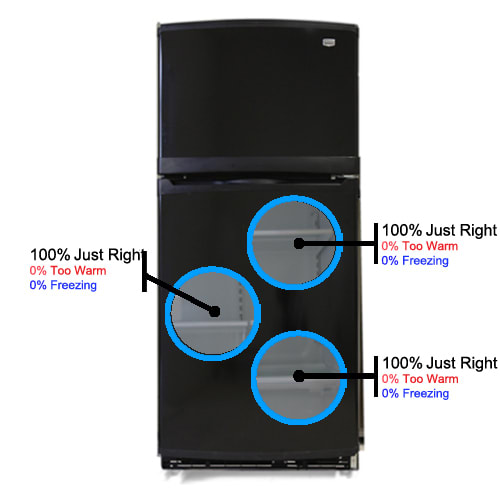
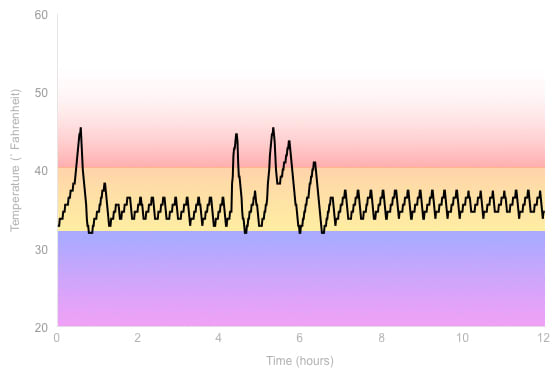
Freezer Temperature
{{section_header}}{{section.name}}{{/section_header}}
Temperatures also varied within the fridge, but didn't vary over time. That's what's important, since fluctuations in temperature are what cause freezer burn.
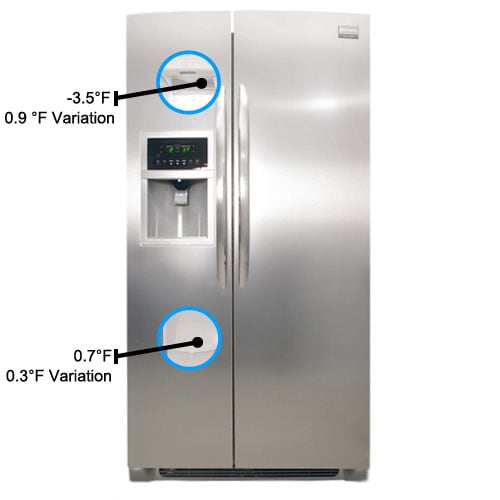
Vegetable Drawer
{{section_header}}{{section.name}}{{/section_header}}
The simulated vegetable we put in the vegetable drawer lost only 0.07 grams of water per hour. That's remarkable performance, and proof that this GE will keep your veggies crisp.
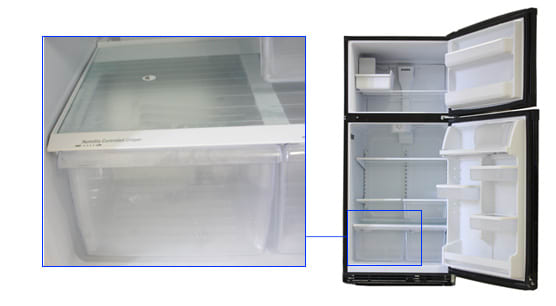
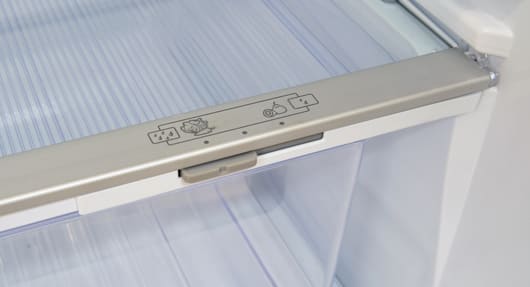
Power Loss
{{section_header}}{{section.name}}{{/section_header}}
When unplugged, food in the freezer compartment was still fully frozen even after 36 hours. That proves that the fridge is well-insulated, and gives you an idea how long your ice cream will last if the power goes out.
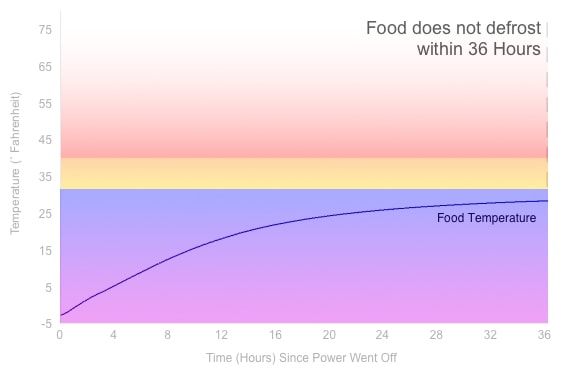
Freezing Performance
{{section_header}}{{section.name}}{{/section_header}}
A rapid freeze means food won't end up with ice crystals and, by extension, a funny texture when it's thawed. It took just over an hour and a half for the {{product.name}} to bring room temperature food below 32 degrees Fahrenheit, which is about average.

Usable Space
{{section_header}}{{section.name}}{{/section_header}}
Two adjustable shelves, one fixed shelf, a deli drawer and two crisper drawers are inside the fridge compartment.
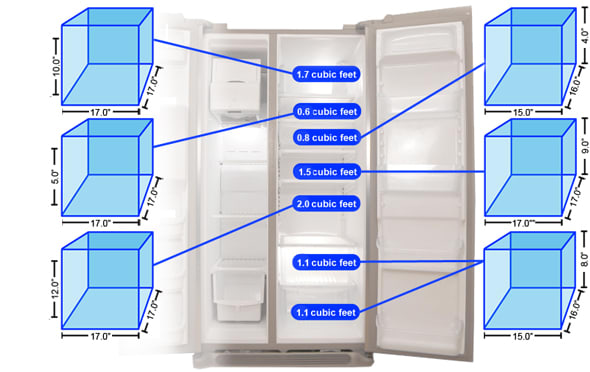
Two fixed shelves, a dairy drawer and two adjustable shelves are on the fridge door.
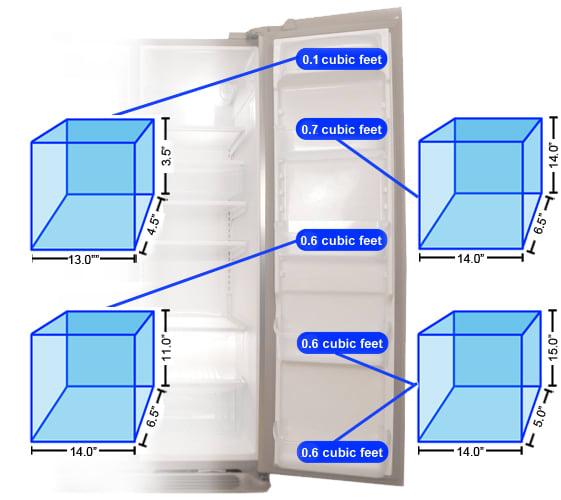
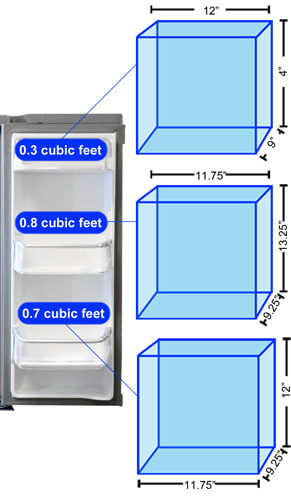
The freezer features minimally adjustable wire shelves, and a small storage area above the ice maker.
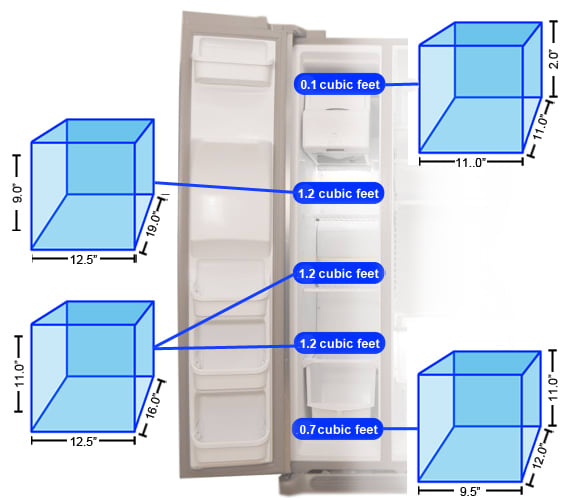
Freezer door shelves are shallow and fixed.
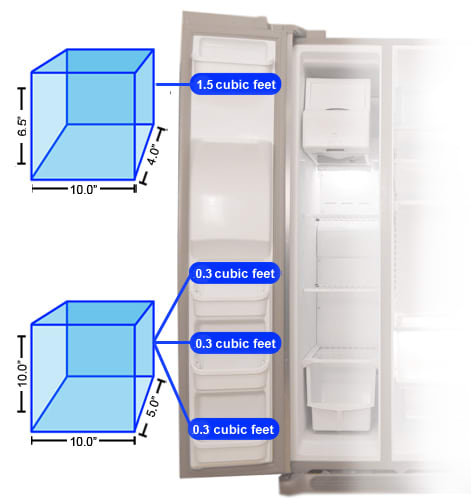
Below are the manufacturers own figures for capacity, and our own measurements for usable capacity. The manufacturers figures do not take account of the shelves, drawers and other removable features, but our measurements do account for the space these take up.
Ease of Access
{{section_header}}{{section.name}}{{/section_header}}
If you've ever lost a jar of mayo or some Chinese leftovers in the back of a deep fridge, the {{product.name}}'s sliding shelves are a nice touch. Yes, shelves that hook onto rear rails are harder to adjust than ones that slide into grooves on the fridge interior's sides. However, these slide out and let you access the very back of the fridge.
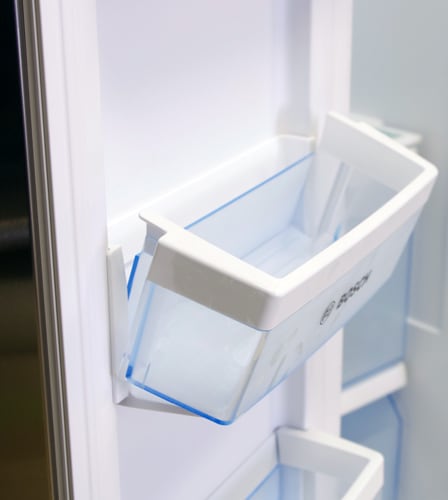
Controls
{{section_header}}{{section.name}}{{/section_header}}
Controls are on the fridge exterior, right above the ice/water dispenser. Unlike most mid-range fridges, the temperature controls actually display a true temperature instead of a number between one and four, or a series of stars. You can even make the temperature go up or down without scrolling through every potential option.
All controls are on a front panel. You don't have to open the fridge to change the temperature, and the controls are very easy to use.

Water Dispenser
{{section_header}}{{section.name}}{{/section_header}}
Water shoots out pretty quickly -- enough to cause splashes on the front of the fridge.

Ice Maker
{{section_header}}{{section.name}}{{/section_header}}
Ice is made in the top of the main freezer compartment, then dispensed through a chute in the freezer door.

Cleaning
Noise
Other Features
{{section_header}}{{section.name}}{{/section_header}}
{{product.manufacturer_specs['Other Features Photo BROKEN?']}}
Specs
{{section_header}}{{section.name}}{{/section_header}}
The fridges sell for about the same amount and have very similar specs, though the Frigidaire is slightly larger.
Design
{{section_header}}{{section.name}}{{/section_header}}
The Frigidaire has a slightly more modern exterior, and both have all controls on the exterior and through-the-door ice and water.
Performance
{{section_header}}{{section.name}}{{/section_header}}
Where the GE's temperatures varied across shelves but stayed consistent over time, the Frigidaire's temperatures fluctuated during our tests. That can lead to premature food spoilage.
{{score_bars comp_num="1", scores="Power Use Rating, Running Cost Rating, Fridge Temperature Rating, Power Loss Rating, Freezer Temperature Rating, Freezing Test Rating"}}
Storage Space
{{section_header}}{{section.name}}{{/section_header}}
The GE and Frigidiare both had equivalent storage spaces.
{{score_bars comp_num="1", scores="Freezer Usable Space Rating, Fridge Usable Space Rating"}}
Usability
{{section_header}}{{section.name}}{{/section_header}}
The GE and Frigidaire are both easy to clean, though the Frigidaire has flimsy shelves and drawers in comparison to the GE.
{{score_bars comp_num="1", scores="Usability Ease of Access Rating , Usability Controls Rating, Usability Water Rating, Usability Icemaker Rating, Usability Cleaning Rating"}}
Specs
{{section_header}}{{section.name}}{{/section_header}}
The larger GE GSL25JGCLS can be found for under $1000.
Design
{{section_header}}{{section.name}}{{/section_header}}
Both fridges feature dated designs, marked by thick black plastic ice dispensers.
Performance
{{section_header}}{{section.name}}{{/section_header}}
Both fridges have good freezer performance, but the GE's temperature variations based on location within the fridge compartment are greater than the KitchenAid's.
{{score_bars comp_num="2", scores="Power Use Rating, Running Cost Rating, Fridge Temperature Rating, Power Loss Rating, Freezer Temperature Rating, Freezing Test Rating"}}
Storage Space
{{section_header}}{{section.name}}{{/section_header}}
The larger GE has the upper hand on storage space, especially on the freezer door.
{{score_bars comp_num="2", scores="Freezer Usable Space Rating, Fridge Usable Space Rating"}}
Usability
{{section_header}}{{section.name}}{{/section_header}}
The GE's sliding shelves and easy-to-clean exterior makes it the clear winner in this measure.
{{score_bars comp_num="2", scores="Usability Ease of Access Rating , Usability Controls Rating, Usability Water Rating, Usability Icemaker Rating, Usability Cleaning Rating"}}
Specs
{{section_header}}{{section.name}}{{/section_header}}
Real stainless, and for the same price as the GE if you're a good bargain hunter
Design
{{section_header}}{{section.name}}{{/section_header}}
The MSD2576VEM's exterior is real stainless, and without a lot of black plastic the fridge has a sleeker design than the GE.
Performance
{{section_header}}{{section.name}}{{/section_header}}
Both fridges suffered from uneven temperatures across shelves, but the Maytag did a slightly better job. The GE's freezer froze food faster.
{{score_bars comp_num="3", scores="Power Use Rating, Running Cost Rating, Fridge Temperature Rating, Power Loss Rating, Freezer Temperature Rating, Freezing Test Rating"}}
Storage Space
{{section_header}}{{section.name}}{{/section_header}}
Both fridges have similar storage capacities.
{{score_bars comp_num="3", scores="Freezer Usable Space Rating, Fridge Usable Space Rating"}}
Usability
{{section_header}}{{section.name}}{{/section_header}}
The GE's sliding shelves are a much better feature than the Maytag's gimmicky beverage chiller.
{{score_bars comp_num="3", scores="Usability Ease of Access Rating , Usability Controls Rating, Usability Water Rating, Usability Icemaker Rating, Usability Cleaning Rating"}}
Conclusion
Energy Efficiency
A year with the {{product.name}} would cost you under $40, assuming electricity sells for 9.1 cents per kWh. That's pretty good for a fridge this size.
Performance
The {{product.name}} has average temperature control all around, with the exception of the fridge. It keeps foods at even temperatures over time, but those foods vary in temperature depending on which shelf they're stored. Foods towards the bottom of the fridge can be several degrees warmer than foods toward the top.
Storage Space
The {{product.name}} has lots of usable storage space. It's not as wide as a French door, top- or bottom-freezer fridge, but as long as you aren't storing very wide items in the freezer you should be fine.
Usability
Shelves are adjustable, easy to clean, good at containing spills and -- most importantly -- slide out for easy access. The faux-stainless exterior is easier to clean than real stainless, but it may rust if scratched.
Meet the tester
Keith was the Editor in Chief of Reviewed's appliance and automotive sites. His work has appeared in publications such as Wired, Car & Driver, and CityLab.
Checking our work.
Our team is here to help you buy the best stuff and love what you own. Our writers, editors, and experts obsess over the products we cover to make sure you're confident and satisfied. Have a different opinion about something we recommend? Email us and we'll compare notes.
Shoot us an email